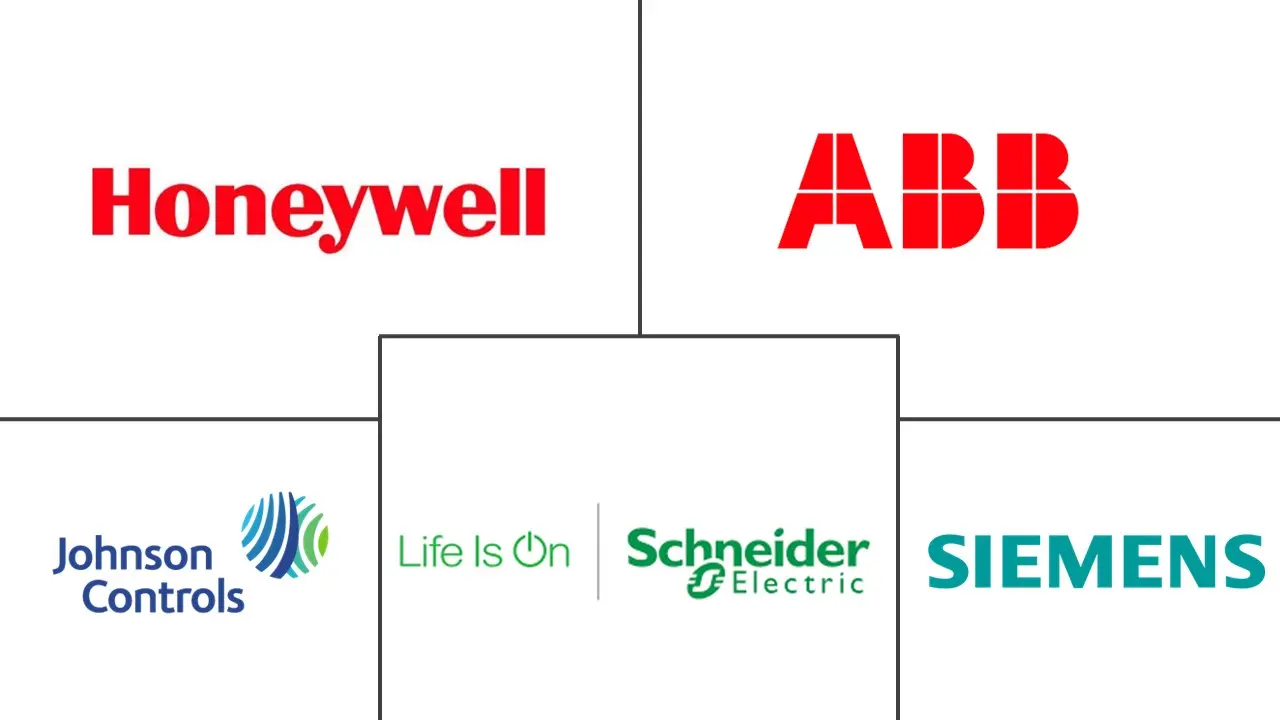North America Building Automation Systems Market Size and Share
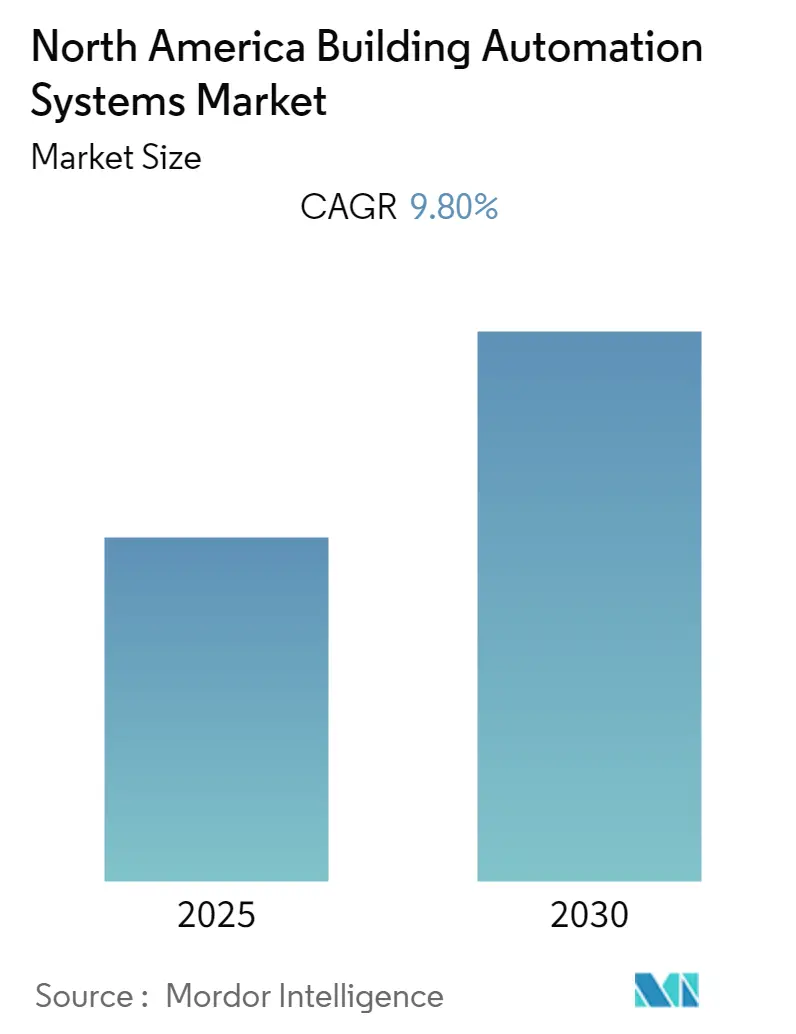
North America Building Automation Systems Market Analysis by Mordor Intelligence
The North America Building Automation Systems Market is expected to register a CAGR of 9.8% during the forecast period.
A building automation system (BAS), also referred to as a building control system or a building management system, is a system that controls several electric, electronic, and mechanical systems throughout a building. Components like building management systems, lighting controls, fire detection, HVAC controls, and security systems are included in the scope of the study and span across end-users like residential, commercial, and industrial.
- Owing to an increasing number of commercial buildings, the growing demand for reductions in energy consumption levels and the continuing growth of energy usage created a need to develop innovative techniques to reduce and optimize building energy use in North America. Moreover, building energy management systems (BEMS) have gained popularity because of the increasing interest in energy conservation and savings. Building energy management systems can control and monitor the building's energy needs.
- Reducing energy consumption has been a primary concern among commercial building owners and managers to save money. According to the US Energy Information Administration, almost 40% of the energy consumed in the country powers commercial and residential buildings. According to the New York State Energy Research and Development Authority (NYSERDA), enabling real-time energy management systems and smart technologies can reduce costs by an average of 15%. Such developments have been influencing the demand for EMS as part of smart solutions in both commercial and residential buildings.
- Moreover, according to the US Department of Energy, the building sector accounted for about 76% of the electricity used, resulting in a considerable amount of associated greenhouse gas (GHG) emissions, thereby making it necessary to reduce energy consumption in buildings to comply with the national energy and environmental challenges and decrease costs to building owners and tenants.
- Furthermore, according to NRCan, in Canada, over 81% of emissions come from energy. Canadians use more energy because of extreme temperatures, a vast landscape, and a dispersed population. The challenges of transitioning to a lower-carbon energy system are numerous. Still, they also present opportunities for Canada to be a global leader by supporting innovative technologies in the power and energy sector, including promoting growing renewables and cleantech sectors and consequently fueling the market.
- The share of fossil fuel use in the building sector's energy demand decreased slightly to around 36%. Furthermore, following these efforts toward executing the SDS initiative, the building sector's CO2 emissions were expected to drop to 8.852 GtCO2 by the end of 2020.
- Technology for building automation systems (BAS) has advanced significantly and is always improving with new capabilities. It is noteworthy that many building managers still manually operate HVAC systems because they have little faith in the building automation system. Due to ignorance or improper configuration of the building automation system by the installation contractors, far too many buildings with perfectly functional building automation systems still have their equipment run manually by the building operators.
- With the COVID-19 outbreak, most commercial and industrial construction projects started at a slow pace, while some were canceled. Production lines at some HVAC manufacturers had to be put on hold for several weeks, and installers saw their new installation projects limited by sanitary guidelines. However, after the pandemic, commercial and industrial construction projects started, which propelled market growth.
North America Building Automation Systems Market Trends and Insights
Increasing Initiatives and Directives for Energy and Operational Efficiency to Drive the Market
- According to the U.S. Department of Energy, buildings are the single largest energy-consuming sector in the U.S. economy. They account for approximately 75% of the nation's electricity use and 40% of its total energy demand. The International Energy Agency says to hit global net-zero targets, all new buildings and 20% of existing buildings must be zero-carbon as soon as 2030.
- To that extent, in August 2021, the U.S. Department of Energy announced over USD 83 million in funding for 44 projects that would lower Americans' energy bills by investing in new energy-efficient building technologies, construction practices, and the U.S. building sector workforce. The department's Building Technologies Office competitively selected these projects from its Building Energy Efficiency Frontiers and Innovation Technologies funding opportunity announcement.
- Additionally, in April 2021, Johnson Controls, a global player in smart, healthy, and sustainable buildings, announced that it was awarded a USD 91 million project with the U.S. General Services Administration (GSA) to improve the facilities and energy efficiency of landmark buildings. As part of the National Deep Energy Retrofit (NDER) program, the GSA is upgrading building technologies to pursue net zero energy consumption while achieving energy goals prescribed in various federal energy acts. Buildings receiving facility improvements over the next three years comprise the New Executive Office Building (NEOB), the Ronald Reagan Building and International Trade Center (RRBITC), the Eisenhower Executive Office Building (EEOB), Jackson Place, the Winder Building, and the Civil Service Building.
- Moreover, Canada has a target to lower total greenhouse gas emissions by 40% to 45% below 2005 levels by 2030 and reach net zero by 2050. Canada is starting a program to offer financial assistance to organizations to enforce a standard to improve commercial and institutional building energy efficiency. The program is developed to get the ISO 50001 Energy Management Standard widely implemented in buildings across Canada. The standard is a structured framework to enhance energy performance by improving the efficiency of energy-intensive assets. The financial assistance is open to industry associations, utilities, indigenous organizations, and municipal, provincial, and territorial governments. The aim is to implement the standard in buildings for the 2023-2024 and 2024-2025 fiscal years.
- Further, the Government of Canada and the Federation of Canadian Municipalities (FCM) are investing in community-building retrofit projects from coast to coast. To that extent, in May 2022, the Minister of Natural Resources and the President of the Federation of Canadian Municipalities (FCM) announced an investment of over USD 3.2 million for 16 municipally led projects. This investment comes from the Green Municipal Fund's Community Buildings Retrofit (CBR) initiative, which enables communities to undertake retrofits and other upgrades to reduce emissions and enhance the energy performance of community buildings.
- Furthermore, according to Construct Connect and Oxford Economics, in 2022, the value of commercial construction by retail was to account for USD 19.64 billion, USD 14.96 billion for hotels, USD 12.05 billion for government, and USD 9.66 billion for sports stadiums. The robust investments directed toward commercial projects create a need for smart building solutions for safety.
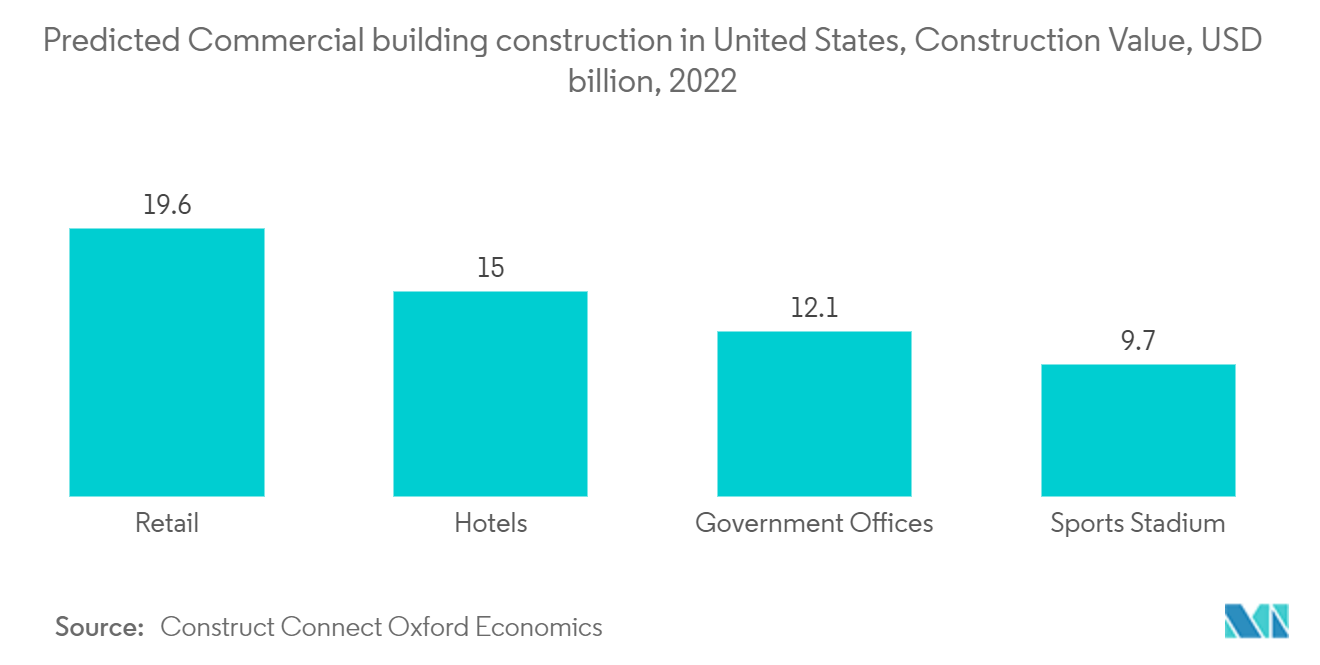
The United States is Expected to Witness Significant Market Share
- With the rise in energy costs and environmental awareness, more and more Americans are looking for smart, connected, and automated building solutions. With the add-in capabilities of safety and alarm systems, fire safety, surveillance, and security are the most commonly installed products. IoT-enabled smart building solutions are also widely accepted in the USA. According to the Energy Impact Assessment of the U.S. Energy Information Administration, the average energy charges in the USA in 2022 were anticipated to increase by 3.9% to 14.26 cents per kWh. Furthermore, according to the EIA, the United States' energy production reached an estimated 101.02 quadrillion British thermal units (Btu) in 2021, while consumption amounted to approximately 97 Btu.
- Furthermore, in October 2021, the U.S. Department of Energy (DOE) announced USD 61 million in funding for ten pilot projects using new technology to transform thousands of homes and workplaces into cutting-edge, energy-efficient structures. These connected communities can interact with the electrical grid to optimize their energy consumption, significantly reducing carbon emissions and energy costs.
- Energy management systems are another significant revenue-generating segment under which building HVAC systems hold a considerable concentration. The United States is among the major markets for HVAC systems. According to the Energy Information Administration, or EIA, HVAC was the most energy-intensive application in commercial buildings in the United States. Building operations managers have been concerned about HVAC monitoring and management for decades, and they usually use complicated sensor networks and servers to monitor all of the data.
- Consumer spending capabilities for newer technology also augment adoption and drive vendors to launch new solutions targeting different needs. With reduced semiconductor and sensor costs, more and more companies and start-ups are working together to produce better smart building technology. The USA, especially as a hub for start-ups and with its strong financial and economic presence, has become the top spot for new technology markets such as smart building solutions.
- The governments in the region are also pushing toward adopting such innovative solutions due to the energy-saving benefits offered by such systems. The U.S. Green Building Council runs the 'LEED' program in collaboration with the Bank of America Charitable Foundation, providing support to local governments looking to adopt sustainable solutions.
- Moreover, the U.S. government is upgrading its energy grids to Advanced Metering Infrastructure (AMI) to reduce energy consumption. According to the U.S. Department of Energy, the building sector accounts for about 76% of the electricity used, resulting in a considerable amount of associated greenhouse gas (GHG) emissions, making it necessary to reduce energy consumption in buildings to comply with the national energy and environmental challenges and to decrease costs to building owners and tenants.
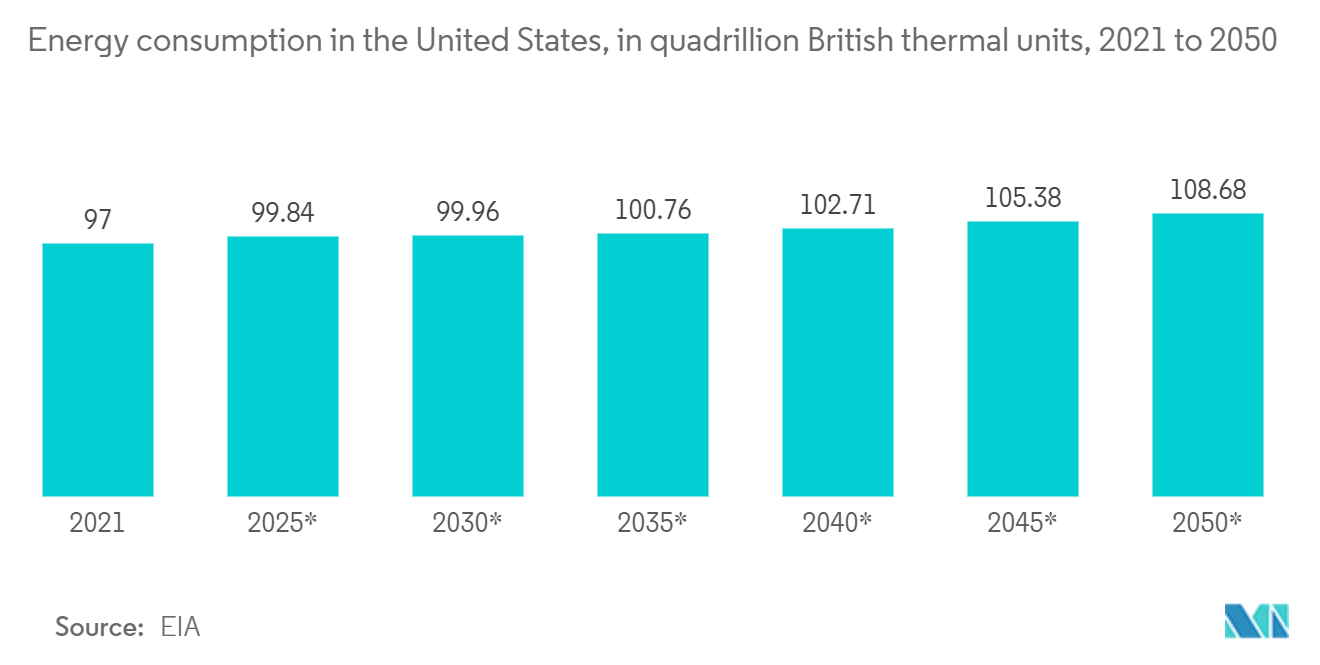
Competitive Landscape
The North American building automation systems market is partially consolidated with the presence of numerous players manufacturing various products in the market. Some of the prominent players in the market include Johnson Control International PLC, Honeywell International Inc., Siemens AG, and Schneider Electric SE, among others.
- May 2023 - According to EIA, in 2022, in the United States, residential buildings had higher energy-related CO2 emissions than the commercial sector. Most of those emissions for residential and commercial buildings came from generating electricity for its use in buildings. Coal was by far the less common source of energy for buildings based on the low level of carbon dioxide emissions.
- June 2022: Siemens Smart Infrastructure introduced Building X, a new open, interoperable, and fully cloud-based smart building package. The suite was the first next-generation product based on the design principles of Siemens Xcelerator, an open digital business platform released to drive digital transformation and value creation in industries such as transportation, grids, and buildings. It eliminates complexity by acting as a single source of truth and supports net zero aims.
North America Building Automation Systems Industry Leaders
Honeywell International Inc.
Johnson Control International PLC
Siemens AG
Schneider Electric SE
Oracle Corporation
- *Disclaimer: Major Players sorted in no particular order
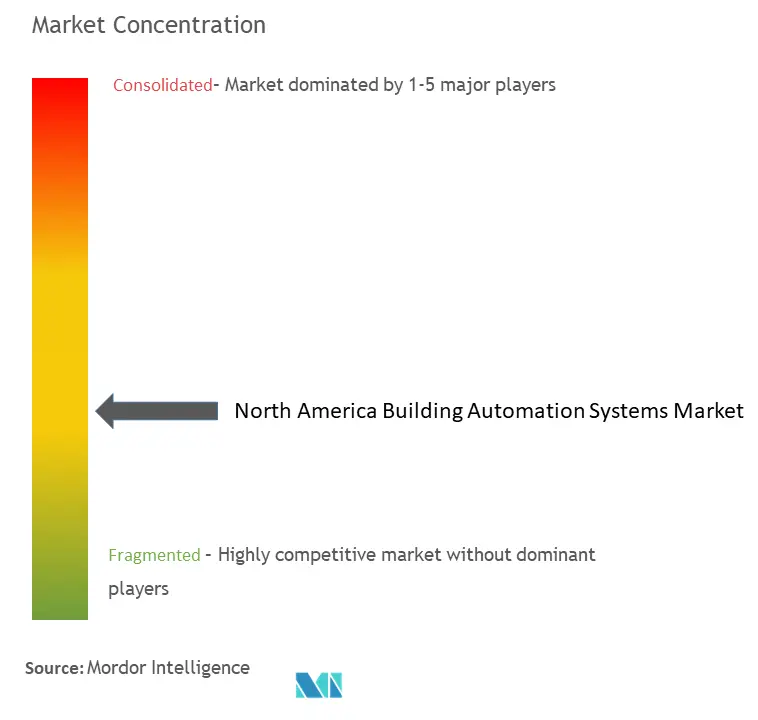
Recent Industry Developments
- March 2023: Siemens Smart Infrastructure introduced Connect Box, an open and simple IoT solution for managing small to medium-sized buildings. The Connect Box is a user-friendly method of building performance monitoring that enhances energy efficiency by up to 30% and significantly improves indoor air quality in small to medium-sized buildings such as schools, retail shops, apartments, or small offices.
- March 2023 - According to EIA, by 2050, the carbon dioxide emissions in the United States are forecasted to have declined across all sectors compared to 2022 levels.
North America Building Automation Systems Market Report Scope
Building automation systems exhibit functions such as control of the building's environment, operating systems depending on energy demand, and monitoring system performance, based on which the systems produce sound alerts as required. Moreover, it centrally controls the building's heating, ventilation, and air conditioning (HVAC), electrical, lighting, shading, access control, security systems, and other interrelated systems.
The North America building automation systems market is segmented by components (hardware [controllers, field devices, and other components], software, and services), end-user (residential, commercial, and industrial), and by country (United States and Canada). The market sizes and forecasts are provided in terms of value in USD for all the above segments.
| Hardware | Controllers |
| Field Devices | |
| Other Components | |
| Software | |
| Services |
| Residential |
| Commercial |
| Industrial |
| United States |
| Canada |
| By Component | Hardware | Controllers |
| Field Devices | ||
| Other Components | ||
| Software | ||
| Services | ||
| By End-user | Residential | |
| Commercial | ||
| Industrial | ||
| By Country | United States | |
| Canada |
Key Questions Answered in the Report
What is the current North America Building Automation Systems Market size?
The North America Building Automation Systems Market is projected to register a CAGR of 9.80% during the forecast period (2025-2030)
Who are the key players in North America Building Automation Systems Market?
Honeywell International Inc., Johnson Control International PLC, Siemens AG, Schneider Electric SE and Oracle Corporation are the major companies operating in the North America Building Automation Systems Market.
What years does this North America Building Automation Systems Market cover?
The report covers the North America Building Automation Systems Market historical market size for years: 2019, 2020, 2021, 2022, 2023 and 2024. The report also forecasts the North America Building Automation Systems Market size for years: 2025, 2026, 2027, 2028, 2029 and 2030.
Page last updated on:
North America Building Automation Systems Market Report
Statistics for the 2025 North America Building Automation Systems market share, size and revenue growth rate, created by Mordor Intelligence™ Industry Reports. North America Building Automation Systems analysis includes a market forecast outlook for 2025 to 2030 and historical overview. Get a sample of this industry analysis as a free report PDF download.
